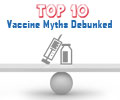A top virologist has blamed the resurgence of polio in India on unscientific policy and inadequacy of the oral polio vaccine (OPV) used for its eradication.
Bangalore: A top virologist has blamed the resurgence of polio in India on "unscientific" policy and "inadequacy" of the oral polio vaccine (OPV) used for its eradication.
Polio cases have risen to 297 so far this year - four-and-a-half times that of last year. Appearance of Indian strains of the virus in neighbouring Nepal and Bangladesh and in far away Africa has alarmed the World Health Organization (WHO).Thekakkara Jacob John, an authority on childhood vaccines and emeritus professor at the Christian Medical College (CMC), Vellore, says the debacle is the result of government decision to "exclusively" use live attenuated OPV ignoring the inactivated (killed) injectible polio vaccine (IPV) of higher efficacy.
The drug regulatory authority even declined to license IPV in India and the public sector IPV plant - set up with French collaboration --was closed down, "strongly suggesting an unscientific bias in favour of OPV and prejudice against IPV", he wrote in the latest issue of the Indian Journal of Medical Research.
He said the government did not even want to "take follow-up action on the findings of a successful trial on IPV in Tamil Nadu".
Health ministry officials were unavailable for comment.
According to John, the "efficacy" of OPV depends on geographic settings. "While a child in America has a 99 percent probability of being fully immunized with three doses of OPV, our trials in Vellore showed only 75 percent and another study in Delhi found it to be even lower. It may be the lowest in western Uttar Pradesh where polio has now flared up," John told IANS in an interview.
Advertisement
"The delivered doses were not providing protective immunity to a substantial proportion of children," John said. "Lack of protection in spite of vaccination is a vaccine failure."
Advertisement
"The deficiency of OPV effectiveness had been staring at us for years but only now have most stake holders noticed it," he said.
Another drawback with OPV is it does not have "prime boost" effect. In other words, subsequent doses after the first one give lesser and lesser immunity. "What this means is children before they are nine months old must get at least 10 doses of OPV to break the vicious cycle of transmission. This speed of one dose a month is not practical."
According to John, any slip up in immunization pressure may result in wild virus re-infection in other states and exportation to other countries. "Urgent steps are needed to eliminate wild viruses in the shortest time."
The addition of IPV to the ongoing OPV programme "is the most promising way forward to interrupt wild virus transmission in the shortest time", he said.
"Three doses of IPV will provide greater immunity than even 10 doses of OPV."
"By commencing an IPV programme now we will shorten the transition to the final phase of eradication when OPV will no longer be in use," he said.
Another advantage of IPV is that it protects against vaccine-induced paralytic polio (VAAP). Currently some 200 children get VAPP annually.
If India does not succeed in eradication by 2007, wild polio will become notifiable under the international health regulations, the consequence of which could be embarrassing, John said.
Source-IANS
SRM








